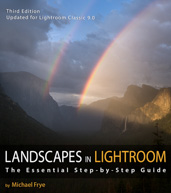by Michael Frye | Jan 8, 2010 | Announcements
 Before they’re completely gone I want to extend an invitation to friends and readers to receive a free copy of my 2010 Yosemite Meditations Mini Calendar. Just visit my new Facebook page, become a fan, email me with your mailing address, and I’ll send you a calendar—while supplies last. (This offer is only available to U.S. residents.)
Before they’re completely gone I want to extend an invitation to friends and readers to receive a free copy of my 2010 Yosemite Meditations Mini Calendar. Just visit my new Facebook page, become a fan, email me with your mailing address, and I’ll send you a calendar—while supplies last. (This offer is only available to U.S. residents.)
by Michael Frye | Jan 5, 2010 | Announcements
In December Jim Goldstein interviewed me for his podcast, “EXIF and Beyond,” and now the podcast is up and available for download. While you’re there be sure to check out Jim’s excellent blog and his many other fascinating podcasts.
by Michael Frye | Jan 1, 2010 | Announcements
 I hope all of you have a great year in 2010.
I hope all of you have a great year in 2010.
by Michael Frye | Dec 22, 2009 | Announcements
After I sent off the text and images for this book some errors crept in. The most prominent is on page 43, where the diagram “Zones and Histograms” shows more dynamic range than any digital camera can produce. I’ve posted corrections on my web site, including an image that you can print and tape over the erroneous diagram on page 43.
by Michael Frye | Dec 17, 2009 | Announcements

My new book, Digital Landscape Photography: In the Footsteps of Ansel Adams and the Great Masters, will be available in January. In this volume I look at the techniques of some past masters of landscape photography—particularly Eliot Porter, Edward Weston, and Ansel Adams—and explore how those techniques could be adapted to digital photography today. The book includes some examples of Porter, Weston, and Adams’ work, as well as at least 100 of my own images. This excerpt from the Introduction explains the theme:
I am sure the next step will be the electronic image, and I hope I shall live to see it. I trust that the creative eye will continue to function, whatever technological innovations may develop.
When Ansel Adams wrote this, digital photography was in its infancy. Today most photographs are captured on digital sensors, and film consumption has dwindled. In this digital age, do the landscape masters of the past like Adams, Edward Weston, and Eliot Porter still have anything to teach us? Can the lessons they learned through trial and error with film, paper, and chemicals still apply to photographers checking the histogram on their camera’s LCD or making a Curves adjustment on their monitor?
The answer is yes. When Ansel Adams developed the Zone System with Fred Archer in 1940, he gave photographers a tool great for controlling their images—but only with black-and-white film, and only with view cameras, where sheets of film could be processed individually. Today any photographer with a digital camera can have even more control—even in color.
Such unprecedented power creates wonderful opportunities, but can also lead to confusion. How do you apply these controls? How far should you go? Do you have to start from the beginning? No, because while the tools may be different, the basic principles that Weston, Porter, and Adams developed still apply.
The first chapter covers the technical foundation like image quality, sharpness, depth of field, and exposure, including how to apply the Zone System to digital cameras, and how to expose for optimum results with HDR. Chapter 2 is devoted to light and composition: directing the eye, using contrast, basic and subtle aspects of light, compositional rules and when to break them, patterns, repetition, and capturing a mood. The third chapter delves into the digital darkroom, including editing, developing a workflow, converting color images to black and white, adjusting black points, white points, and contrast, dodging and burning, and expanding the contrast range with HDR or manual blending in Photoshop.
In the end, the book is a comprehensive look at digital photography techniques from capture to print, with Adams, Weston, and Porter’s insights guiding the way. It’s available for pre-order from Amazon.
 Before they’re completely gone I want to extend an invitation to friends and readers to receive a free copy of my 2010 Yosemite Meditations Mini Calendar. Just visit my new Facebook page, become a fan, email me with your mailing address, and I’ll send you a calendar—while supplies last. (This offer is only available to U.S. residents.)
Before they’re completely gone I want to extend an invitation to friends and readers to receive a free copy of my 2010 Yosemite Meditations Mini Calendar. Just visit my new Facebook page, become a fan, email me with your mailing address, and I’ll send you a calendar—while supplies last. (This offer is only available to U.S. residents.)










